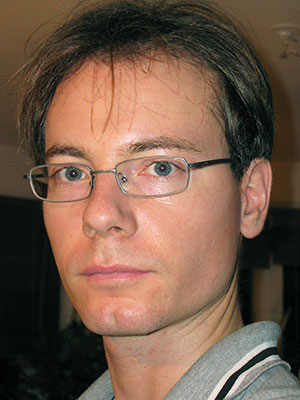Grants for developing microsystems at terahertz frequencies
Microsystems at terahertz (THz) frequencies are a thousand times smaller and lighter, and consume far less power, than today’s THz devices. They also promise a wide range of applications, including high-speed telecommunication links, diagnostic tools for cancer, and radiometers for space and environmental monitoring. Joachim Oberhammer has received a European Research Council Consolidator Grant to make these a reality.

Joachim Oberhammer is one of three researchers at KTH, and ten in Sweden, to receive a 2013 ERC Consolidator Grant. The grant is meant for young researchers who have the potential of becoming global leaders in their field. He will receive about SEK 16 million for excellence in his area, micro and nanosystems, for advancing the research field of radio-frequency micro-electromechanical systems (RF MEMS) beyond 100 GHz, to millimetre, sub-millimetre, and even THz frequencies.
“The grant will give our research team a great deal of research latitude for at least five years, and a guarantee of quality that will facilitate further international collaboration projects. At the same time, as the grant entrusts us with the funds of European taxpayers, it comes a responsibility to utilize this investment for the common good,” says Oberhammer, Associate Professor of Micro and Nanosystems.
According to Prof. Oberhammer, new ways of thinking are needed when attempting to implement microsystems at these frequencies, as simply downscaling concepts from radio-frequencies will not work. What Oberhammer and his team propose is instead to use MEMS fabrication techniques as a toolbox for implementing new types of THz microsystems.
“Micromachining is perfectly suitable for implementing sub-THz electromagnetic geometries because of the excellent fabrication tolerances and feature sizes in the order of a few micrometres. This is impossible to achieve with conventional fabrication techniques,” Oberhammer comments.
His vision is to create a microsystem technology platform that enables radically miniaturized THz systems for broader application. Current THz systems are bulky, need manual assembly, and are not manufacturable in large quantities. The frequency space above 100 GHz is heavily sought after, but current THz technology is not yet mature.
“Our proposed THz microsystems would be 1000 times smaller and lighter, consume significantly less power, and would be clearly manufacturable in large volumes with high levels of product uniformity.
His new concepts could finally enable a widespread utilization of THz technology in many applications in society. Primary applications of his ERC grant include high-speed telecommunication links for small-cell cloud networks, and medical (mainly cancer) diagnosis, which he is already working on together with Karolinska Institutet. Other possible applications are radiometers for space and environmental monitoring, high-resolution short-range radar, and security applications, to mention a few.
Oberhammer is currently a guest researcher at the NASA Jet Propulsion Laboratory (JPL) in Pasadena, California where he sees great opportunities for his concepts.
“People here are extremely interested in concepts that utilize MEMS-tuneable geometries for THz systems, thus creating new possibilities in radio telescopes at submillimetre and far-infrared wavelengths. Space-borne instruments, in particular, require low size and weight. My ideas for the ERC grant, in connection with the expertise of JPL on THz systems, provide a very promising platform for high-impact research.”
The team is also working to integrate micro-electromechanical actuators that can switch or tune these kinds of THz microsystems, and result in reconfigurable, frequency-agile miniaturized THz systems.
“For frequencies around 100 GHz with MEMS-configurability we have shown near-ideal electromagnetic performance, now this has to be brought on step beyond, THz frequencies”.
For more information, contact Joachim Oberhammer, joachim.oberhammer@ee.kth.se .
